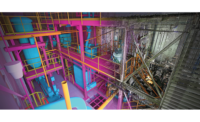The workers on the Birmingham, Ala., high-rise jobsite weren't sure what to make of the two college kids who turned up with a ton of questions. "At first, groups of end users are wondering what the hell you are doing with them," said Nickolas Madsen. "Then you show them the sketches, and they get it."
When he walked onto that jobsite in fall 2011, Madsen was a senior industrial design student at Auburn University's Studio Build program, part of the Center for Construction Innovation and Collaboration in the McWhorter School of Building Science. In the program, industrial- design and building-science students research and develop new tools tailored to the construction industry.
"Students like to be associated with real things, real people, so they can make a direct contribution to industry," said Professor Paul Holley, one of the heads of the Studio Build program. This fall, the program has 31 participants, a mix of undergraduate and graduate students. While not degreed, the program offers partial credit and burnishes student portfolios.
End-user surveys and feedback have generated many original design concepts in the program's seven years, from ergonomic masonry trowels to Velcro heating wraps for PVC pipe. Steve Williams, director of the Center for Construction Innovation and Collaboration, cites these projects as examples of the interdisciplinary creativity the program fosters. "It's the first time, to my knowledge, anybody, academically, has combined industrial-design and construction students, and what they get to do is work on problems in the world's largest industry. "
In recent years, direct relationships with tool manufacturers have brought a new level of focus. "We're working with Knaack, Dewalt, Leica and a few other folks," said Holley. "It's one thing to have the end users on the team, but to have the manufacturers help us figure out solutions that are practical made a big difference."
The program operates on a roughly one-year development cycle for new product ideas, beginning each summer. Small student teams fan out to construction sites and develop academic ethnographies of worker needs, observing and documenting behavior with photographs and surveys.
In the fall, students, usually industrial-design majors, meet with representatives of toolmakers and consider their options. "Some of these students had ideas that were way ahead," recalls Gary Petersen, Knaack vice president for product development. "These students are good at listening [and] at human-centric observation, but they can't design the product just for one guy on the jobsite." Industrial-design seniors Nickolas Madsen and Taylor Mundt set to work designing a "gangbox" storage unit for Knaack. "A secure strong box is not that sexy, but there's always a better way of doing things." said Petersen.
The gangbox—a shared toolbox—went through many iterations. Early sketches incorporated touch screens and smartphone apps for tool management; others had elaborate telescoping panels to hold every conceivable type of tool. "We tried interchangeable panels to divide up the storage space, but everything got jumbled up," said Madsen. Feedback was appreciated. "Knaack worked very closely with us. This is what it is like as a designer in the real world."
Students submit their designs at the end of the semester, and a new team takes up the project in the spring. Charlie Humphreys and Jack Thomas were building-science seniors when they began working on the Knaack gangbox in spring 2012.
"Nick and Taylor came up with the prototype," said Humphreys. "Our question to end users was, what do you want to see in a gangbox? To Knaack, [we asked] what product could you sell at a profit?" Humphreys and Thomas devised a methodology for evaluating the prototype and improving the design. "The industrial-design people are not blinded by the construction mind-set and got around problems we wouldn't have thought of."











Post a comment to this article
Report Abusive Comment